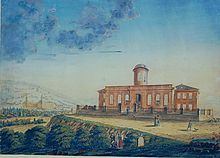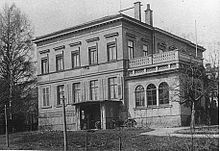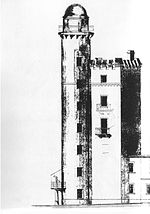Gotha observatory
The Gotha observatory was a ducal foundation for the purpose of astronomical research. It consisted of several research facilities in the city of Gotha . It was set up on the initiative of Duke Ernst II (1745–1804).
The Duke was able to win the astronomer Franz Xaver von Zach as the first director in 1786 , who soon led the observatory , which was later built on the Seeberg , to a high reputation - u. a. through the first astro-geographic conference and later Europe-wide measurement campaigns to search for minor planets (establishment of the Sky Police ).
prehistory
Ernst v. Saxe-Gotha was the second son of Duke Friedrich III. (Sachsen-Gotha-Altenburg) was not intended for the succession and received thorough scientific training. When he had to take over the reign in 1772 due to the untimely death of his older brother, he remained true to his scientific interests. His preferences were physics and astronomy.
Ernst II spent 38,000 thalers from his apanage for the later construction of the Seeberg observatory and 20,000 thalers for its equipment. This scientific institution should - according to his testamentary wish - represent the only visible monument of his life and be appropriately preserved by his successors. He invested a capital of 40,000 thalers for this purpose, which with its 4 percent interest should cover the future costs of building maintenance and the astronomer's salary.
Research facilities in Gotha
The castle observatory
In addition to a physical cabinet headed by the secretary Ludwig Christian Lichtenberg from Göttingen , he had a small observatory built at Friedenstein Palace . Ernst II already had excellent astronomical instruments. He owned four precise pendulum clocks for measuring star passages , one of which had a rust-shaped compensation rod from JA Klindworth from Göttingen. Furthermore, a biped quadrant by Klindworth, two Short mirror telescopes built according to the Gregory system, two achromatic refractors and a mirror octant by Jesse Ramsden from London .
He began his astronomical observations here, but they did not satisfy him due to insufficient scientific advice. The duke tried to find a trained astronomer , whom he was finally able to win in Franz Xaver von Zach . Zach arrived in Gotha in June 1786 and was taken on as an officer (major) and court astronomer . From now on, Gotha's astronomical epoch began .
In the fall of the year, the duke couple and Zach began an astronomical journey to the south of France. A temporary observatory was set up there in Hyères . After their return in the spring of 1787, Duke Ernst II and FX Zach continued their observations at the castle observatory. The Duchess Marie Charlotte Amalie also participated as an astronomical calculator . The results were then published as the solar table Tabulae Motuum Solis and the star catalog Catalogus Novus 1792.
The observatory on the Seeberg
→ Main article Seeberg observatory
construction
In 1790 the Seeberg observatory on the Kleiner Seeberg was put into operation. It served as an astronomical observatory until 1839 . Equipped with the most modern - mostly English - instruments, it was considered a model for other observatories , such as the Göttingen observatory .
According to Franz Xaver von Zach's plans, a massive observatory building was built in an east-west orientation, which offered space for the installation of two wall quadrants , a passage instrument and the associated clocks. In the middle of the building a small round tower with a rotatable domed roof was to rise above the entrance hall, in which a whole circle was to be erected. A solid building at ground level was created (as a meridian hall ) with two residential and farm buildings set at right angles.
The quadrants , the passage instrument from Ramsden with a focal length of 2.40 m, the astronomical clocks , including the sidereal time clock from Arnold and the master clock from Mudge & Dutton and numerous other astronomical and meteorological instruments were set up in four rooms . There was a vertical circle of Carry in the rotating dome . With this design and equipment, the Seeberg observatory was the most modern observatory in Germany at the time and one of the most modern research facilities around 1800.
Led by Franz Xaver von Zach
The fame of the observatory spread very quickly and the lively correspondence between Franz Xaver von Zachs made it a popular destination for astronomers at the time. In 1798 the " First European Astronomers Congress " took place. The first astronomical journals went to all countries from Gotha.
Other scientific achievements of the Seeberg observatory under Zach's direction were the rediscovery of the asteroids Ceres and Pallas , the founding of an astronomical society and the further development of geodesy in preparation for the Prussian land surveying. For this purpose, a geodetic base in the Seeberger Meridian, the measuring section Seeberg-Sternwarte - Schwabhausen , which was used several times later , was precisely defined.
The death of Duke Ernst II on April 20, 1804 initially ended the fruitful work. In 1806, Zach sent the observatory items back to Gotha, where they were stored in Friedenstein Castle due to the threat of war.
The successors of Zach
In 1808 Bernhard von Lindenau was commissioned by the now ruling Duke August von Sachsen-Gotha-Altenburg to re-establish the observatory and was appointed director of the facility.
However, structural damage soon became noticeable. In 1810 the tower had to be demolished and in 1811 the two side buildings. On the west side of the meridian hall, a new residential building was built for the astronomer, an adjunct and the castellan .
Bernhard von Lindenau published in 1810 his Venus tables , 1811's Mars tablets and 1813 tablets of Mercury's orbit . In 1813 the observatory was occupied by the French and many of its papers were burned. The devices were not damaged.
Friedrich Nicolai was appointed as adjunct of the observatory in 1814 and later appointed (vice) director.
Johann Franz Encke was appointed (vice) director in 1818 and continued the scientific work. Encke calculated the orbital time of the comet Pons as the shortest known orbital time ( Encke's comet ) and the solar parallax from the Venus passages of 1761 and 1769, which was valid for a long time.
In the 1820s the observatory was equipped with a Fraunhofer heliometer and an Ertel meridian circle .
Peter Andreas Hansen arrived in Gotha in 1825 as the new director. His focus was the movement of the earth's moon , for which he developed precise formulas. In 1839 he left the Seeberg because he noticed the constant decay and demanded the construction of a new observatory that corresponded to the legacy of Ernst II. The house now served as a restaurant, which, however, burned down completely as a result of a chimney fire on the occasion of a carnival event on February 19, 1901. It was not until 1904 that a new restaurant building built according to plans by Richard Klepzig was inaugurated at Easter . At that time the innkeeper was Christoph Walther (1849–1928). During the times of the GDR , the restaurant operated under the name "Old Observatory". In 1996 the restaurant was reopened by a private operator.
In 1856 the Gotha state parliament decided to build the new ducal observatory on the site of the former court smithy using materials from the Seeberg observatory.
Today two memorial plaques in the outer area of today's restaurant "Alte Sternwarte" remind of the Seeberg observatory. The so-called meridian stone was also preserved.
Hansen's interim observatory
The house of the Hansen family was expanded into an interim observatory with a small annex for astronomical equipment. Here Hansen worked on his theoretical and practical work for twenty years. He brought the land survey to an end, for which he was appointed Privy Councilor and member of the government for surveying issues.
He also improved his lunar theories, for which he used the meridian circle and astronomical clocks housed in the annex . In close collaboration with the English astronomer George Biddell Airy in Greenwich , the fundamental work Tables de la Lune was created , which was published in 1857 by the British government. Hansen was rewarded with £ 1,000 for this. Numerous astronomers visited him in his observatory, some of whom stayed for months to assist and study. He received numerous honors and was appointed President of the Permanent Commission of European Grade Measurement in 1864.
Hansen had to check the old observatory on the Seeberg every week. He noticed the steady decay and now demanded the construction of a new observatory that corresponded to the legacy of Ernst II. He obtained statements from specialist colleagues who supported this project. Even Alexander von Humboldt turned to the Gotha government about this.
In 1856 the Gotha state parliament decided to build the new ducal observatory on the site of the former court smithy using materials from the Seeberg observatory.
Observatory Jägerstrasse 7
New building in 1859
The new construction of the observatory according to plans by the Gotha building officer Gustav Eberhard was completed in 1859, and the Peter Andreas Hansen family moved into the building. The observatory was built entirely according to Hansen's ideas for astrometric research by a single astronomer, but also contained rooms for teaching purposes. An extension for the emerging astrophysics was not considered.
A meridian hall (marked A in the floor plan) with the Ertel meridian circle and a Reichenbach theodolite and an observation room in the 1st quarter (B), in which the passenger instrument was located, were connected to the solid residential building . So there were possible uses for all existing instruments.
Additional astronomical clocks and an equatorial for absolute measurements in all directions, which was set up in the tower (C), were purchased. The device was a new design by Repsold in Hamburg . The clocks now had electrical contactors that should rule out personal observation errors. Room (D) housed the library and (E) the astronomer's study.
This observatory again became a center for scientific exchange and mutual visits by scientists. Nevertheless, Peter Andreas Hansen missed constant contact with specialist colleagues. He ran the facility until his death in 1874.
The will of Ernst II was taken into account by placing a plaque above the entrance to the observatory from the garden. It bore the following inscription:
IN VICINO MONTE OLIM CONDITA FROM ERNESTO II: DG ET A.
OPPORTUNIORE LOCO NUNC REST. AB ERNESTO II. DC ET G.
MDCCCLVII
(Ernestine observatory, once donated by Ernst II Duke of Gotha and Altenburg, on a neighboring mountain, now restored at a more favorable location by Ernst II Duke of Coburg and Gotha, 1857)
The history of the property as an observatory ended in 1934 when Ernst Anding retired , and from then on it was used for residential purposes. Fortunately, it remained undamaged during the war. A Gotha planning office acquired the building in 2001 and renovated it.
In 2007 the plaque, which had been damaged by the war, was restored to the public with funds from the Gotha Cultural Foundation.
Location of the observatory: location
The astronomers of the observatory Jägerstrasse 7
Director = D. Assistant = A, Administrator = V, Observator = O
- Peter Andreas Hansen (1860–1874) D
- Adalbert Krueger (1876–1880) D
- Leo Anton Carl de Ball (1875–1878) A, V
- Hugo von Seeliger (1881–1882) D
- Ernst Becker (1883–1887) D
- Paul Harzer (1887-1896) D.
- Carl Rohrbach (1887–1906) V.
- Ernst Jost (1902–1904) O
- Ernst Anding (1906–1934) D
Bad financial situation and decline
The poor financial situation made it very difficult to recruit and retain suitable astronomers for the Gotha observatory. Almost all of them broke off their stay due to insufficient pay after a short or long stay.
From Helsinki could Adalbert Krueger obtained that here his zone observations of stars between 55 and 65 degrees north declination continued, which he published in Helsinki 1,883th He was assisted by Andreas Donner and, from 1878, Leo de Ball . Even after Krueger's departure in 1880, the latter remained in Gotha as administrator of the observatory until 1882.
Hugo Seeliger from Leipzig stayed in Gotha for barely a year until he moved on to Munich as a professor .
Ernst Becker from Berlin stayed longer and continued observing special stars here. He had the equatoreal , which had not proven itself as a measuring device, converted into a normal parallactic refractor. Becker also created the catalog for the observatory library. In 1887 he was called to Strasbourg .
The Jägerstrasse observatory once again had its last heyday under the direction of Paul Harzer . Harzer came from Pulkowo and was both an active practical and theoretical astronomer. He quickly settled in Gotha, faced various problems with his observations on the meridian circle , the results of which he published on an ongoing basis. Through his marriage to a granddaughter of Peter Andreas Hansen, also family-related to Gotha, he also developed active public relations. There were private seminars, public observation evenings and, in 1894, a meeting of the Association of Friends of Astronomy and Cosmic Physics ( VAP ) in Gotha. His appointment as professor in Kiel in 1896 ended this fruitful phase.
For several years the high school director Carl Rohrbach was entrusted with the administration of the observatory. The devices were used from 1902 to 1904 by Ernst Jost , who was the first assistant at the Strasbourg observatory at the time .
In 1906 a scientific astronomer could be won for Gotha again with Ernst Anding . Anding had successfully worked theoretically and practically in Munich and made it to extraordinary professor. In Gotha he was able to complete and publish this work as a professor and observatory director. He modernized parts of the observatory by installing a clock system as a gift from Riefler in Munich, which also controlled the public clocks in the city via a long-distance line to the town hall. He could also set up a modern passenger instrument. The instrumental equipment was brought up to a high level again. Nevertheless, in 1934 the observatory was spun off from the Ducal Foundation for Culture and Science and the facility closed. This deviated from Ernst II's will.
The more modern devices were handed over with part of the library to the observatory of the University of Jena . The historical devices were awarded to the Deutsches Museum in Munich and the Regional Museum in Gotha, and the library was incorporated into the Gotha University and Research Library .
Use of the former observatory until today
In 1934 the building complex was completely converted into a residential building. The former home of the Hansen family, the interim observatory, was destroyed in an air raid in February 1945. The division into several residential units led to serious interventions in the structural structure. Today the building houses an office on the ground floor. On the upper floor and in the observatory building, three apartments were built, which also reflect the historical building structure and spatial effect in their floor plans.
On April 18, 2007, the renovated plaque above the observatory entrance and a memorial plaque at the entrance to the residential building were inaugurated. The latter contains the following text:
“ This building, erected in 1857 by master builder Scherzer, served as the home and workplace of PETER ANDREAS HANSEN (1795–1874), IMPORTANT ASTRONOMER AND GEODE OF THE 19TH CENTURY. Since 1825, as director of the Gotha observatory, he contributed significantly to the development of astronomy in his time through astrometric observations, through calculations of the orbits of the moon and planets with their disturbances, and through the construction of observation devices. As a geodesist, he carried out the national survey of the Duchy of Gotha from 1838, developing new calculation methods such as the 'Hansen Task' and was later involved in the European degree measurement . The 'Neue Herzogliche Sternwarte' (New Ducal Observatory), which was moved behind this residential building in 1859, with its instruments, was considered to be a model for an astronomical observatory. - German Association for Surveying, Regional Association Thuringia, and Federation of Publicly Appointed Surveying Engineers, Regional Group Thuringia, 2007 "
The Rohrbach Tower
The cityscape of Gotha is dominated by a tower crowned with a dome, which is generally regarded as the Gotha observatory. This is Carl Rohrbach's private observatory , which he had built in 1904 as one of the first reinforced concrete towers in Germany. After the death of the school principal and amateur astronomer in 1932, the tower was used in different ways. For a few years a radiation research center of the Meteorological Service was housed there. The tower has been restored in recent years and the URANIA educational association is now using the observation facilities. The tower was sold in 2005 and is intended for residential purposes. The dome was damaged and removed by hurricane Kyrill in spring 2007; it was replaced by a new one in June 2007.
Location of the Rohrbach tower: Rohrbach tower
The Arnoldischule also has an observatory dome with observation possibilities.
Dome of the Arnoldischule: Arnolditurm
Seebergsternwarte: Seebergsternwarte
literature
- Manfred Strumpf: Gotha's astronomical epoch . Geiger, Horb am Neckar 1998. ISBN 3-89570-381-8 .
- Manfred Strumpf and Thomas Marold: On the history of the Gothas observatories , Gothaer Museumsheft 1985, pp. 33–48, full text .
- Ernst Jost: The observatory on the Seeberg . In: Rudolf Ehwald (ed.): From the coburg-Gothaischen lands. Homeland papers . Book 3. Perthes-Verlag, Gotha 1905, p. 27-40 .
Coordinates: 50 ° 56 ′ 34.7 " N , 10 ° 42 ′ 33.2" E






